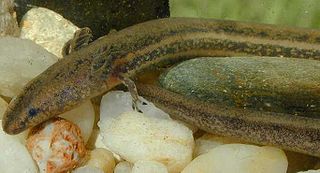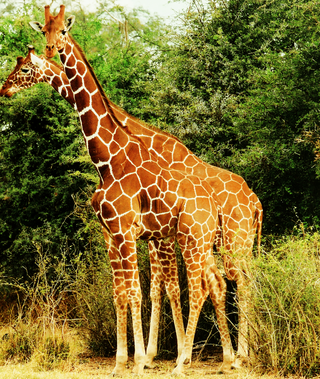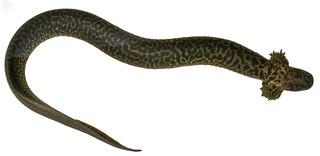
Salamanders are a group of amphibians typically characterized by their lizard-like appearance, with slender bodies, blunt snouts, short limbs projecting at right angles to the body, and the presence of a tail in both larvae and adults. All ten extant salamander families are grouped together under the order Urodela from the group Caudata. Salamander diversity is highest in eastern North America, especially in the Appalachian Mountains; most species are found in the Holarctic realm, with some species present in the Neotropical realm.

Plethodon is a genus of salamanders in the family Plethodontidae. They are commonly known as woodland salamanders. All members of the genus are endemic to North America. They have no aquatic larval stage. In some species, such as the red-backed salamander. Young hatch in the adult form. Members of Plethodon primarily eat small invertebrates. The earliest known fossils of this genus are from the Hemphillian of Tennessee in the United States.

Sirenidae, the sirens, are a family of neotenic aquatic salamanders. Family members have very small fore limbs and lack hind limbs altogether. In one species, the skeleton in their fore limbs is made of only cartilage. In contrast to most other salamanders, they have external gills bunched together on the neck in both larval and adult states. Sirens are found only in the Southeastern United States and northern Mexico.

The greater siren is an amphibian and one of the three members of the genus Siren. The largest of the sirens and one of the largest amphibians in North America, the greater siren resides in the coastal plains of the southeastern United States.

Siren is a genus of aquatic salamanders of the family Sirenidae. The genus consists of five living species, along with one extinct species from the Eocene Epoch and three from the Miocene.

The lesser siren is a species of aquatic salamander native to the eastern United States and northern Mexico. They are referred to by numerous common names, including two-legged eel, dwarf siren, and mud eel. The specific epithet intermedia denotes their intermediate size, between the greater siren, Siren lacertina, and the dwarf sirens, Pseudobranchus species.

Holbrook's southern dusky salamander, previously known as just the southern dusky salamander, is a species of salamander endemic to the southeastern United States. Older sources often refer to it as the eared triton. Formerly abundant, it has precipitously declined since the 1960s.

The northern dwarf siren is a perennibranch salamander lacking hind legs. Found in the Southeastern United States, it one of two currently recognized species of dwarf sirens. Three subspecies are currently recognized; P. s. striatus, the broad-striped dwarf siren, P. s. lustricolus, the Gulf Hammock dwarf siren, and P. s. spheniscus, the slender dwarf siren.

Chamberlain's dwarf salamander is a species of salamander in the family Plethodontidae, endemic to the United States. It is only found in the states of North Carolina and South Carolina. It was previously thought to be a color morph of the southeastern dwarf salamander, but was described in 2003 as a distinct species based on distinct morphology and behavior. A 2017 study reaffirmed it as being a distinct species. It is estimated that E. chamberlaini diverged from E. quadridigitata anywhere from 27 to 15 million years ago.
The reticulated flatwoods salamander is a species of mole salamander, an amphibian in the family Ambystomatidae. The species is native to a small portion of the southeastern coastal plain of the United States in the western panhandle of Florida and extreme southwestern Georgia. The species once occurred in portions of southern Alabama but is now considered extirpated there. Its ecology and life history are nearly identical to its sister species, the frosted flatwoods salamander. A. bishopi inhabits seasonally wet pine flatwoods and pine savannas west of the Apalachicola River-Flint River system. The fire ecology of longleaf pine savannas is well-known, but there is less information on natural fire frequencies of wetland habitats in this region. Like the frosted flatwoods salamander, the reticulated flatwoods salamander breeds in ephemeral wetlands with extensive emergent vegetation, probably maintained by summer fires. Wetlands overgrown with woody shrubs are less likely to support breeding populations.

The longleaf pine ecosystem is a temperate coniferous forest ecosystem found within the Southern United States. Spanning pine savannas, sandhills and montane forests, it includes many rare plant and animal species, and is one of the most biodiverse in North America. Once one of the largest ecosystems in North America, from Virginia south to Florida and west to Texas, it now occupies less than a quarter of the original range. Degradation of the ecosystem is partially due to excessive timber harvesting, urbanization, and fire exclusion. Although the ecosystem is heavily fragmented at present, it still carries a great diversity of plant and animal species, many of which are endemic. A range of techniques, including planting longleaf pine seedlings, introducing prescribed burning regimens, managing native ground cover, and controlling invasive species within the ecosystem, are used in attempting to preserve this threatened ecosystem.

Batrachochytrium salamandrivorans (Bsal) is a pathogenic chytrid fungus that infects amphibian species. Although salamanders and newts seem to be the most susceptible, some anuran species are also affected. Bsal has emerged recently and poses a major threat to species in Europe and North America.

The reticulated giraffe is a species/subspecies of giraffe native to the Horn of Africa. It is differentiated from other types of giraffe by its coat, which consists of large, polygonal, block-like spots, which extend onto the lower legs, tail and face. These prominent liver-red spots also show much less white between them, when compared to other giraffe species. While the reticulated giraffe may yet still be found in parts of its historic range, such as areas of Somalia and Ethiopia, its population stronghold is primarily within Kenya. There are approximately 8,500 individuals living in the wild.

The reticulated siren, also known as the leopard siren or colloquially as the leopard eel, is a species of aquatic salamander in the family Sirenidae. The species, which is endemic to the southeastern United States, was first formally described in 2018. This cryptic salamander is known only from three localities in southern Alabama and the Florida panhandle and is one of the largest animals in the United States to be newly described in the past 100 years.
David A. Steen is an American herpetologist and conservation biologist. He is Reptile and Amphibian Research Leader of the Fish and Wildlife Research Institute, and was previously a research professor at Auburn University, where he completed his Ph.D. Steen runs a popular Twitter account where he offers reptile and amphibian identification and dispels myths about oft-maligned snakes such as copperheads, cottonmouths, and rattlesnakes.
The Dixie Caverns salamander is a species of salamander in the family Plethodontidae. It is endemic to the state of Virginia in the United States. It is most often found in Roanoke County, but several specimens have been recorded in surrounding counties. It was commonly confused with Wehrle's salamander and was merged with that species shortly after description, but a 2019 study reaffirmed it as a distinct species.

The bog dwarf salamander is a species of salamander endemic to the southern United States.

Valentine's southern dusky salamander is a species of salamander in the family Plethodontidae. It is endemic to the southeastern United States.














